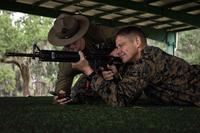At least 60 Iraqis killed and scores more wounded in two suicide bomber attacks in the Baghdad area in the past four days. While the attacks could very well be the death spasms of Al Qaeda in Iraq terrorists, they could also signal an insurgency entering the vacuum created by U.S. troops being pulled off Iraq’s city streets.
One big attack is an outlier. A series of attacks? Well, that's a trend. And there have been a series of high casualty attacks in the past week, including Tuesday’s bombing in the Abu Ghraib suburb west of Baghdad, another on Sunday, when a suicide bomber struck near a police academy in east Baghdad killing 28 police recruits, and last week when a suicide car bomber killed 13 and wounded 60 in Hillah, south of Baghdad.
The insurgent attacks come as U.S. troops leave Iraq’s cities. In fact, U.S. troops have significantly reduced their presence in much of Iraq as part of the Status of Forces Agreement that took effect January 1. On a conference call with bloggers last week, Maj. Gen. David Perkins, director of strategic effects for Multinational Forces-Iraq, said “the U.S. has begun a fairly dramatic withdrawal,” rapidly turning over facilities and areas to the Iraqi government, including the Green Zone, Basra airport along with almost all of southern Iraq and much of Anbar province. The security agreement calls for all U.S. troops to be out of Iraqi cities by June.
“The U.S. has already withdrawn out of a lot of the cities. In fact, since the height of the surge, we have already reduced our forces by over 20 percent. So if you took a look at the number of the forces here at the surge, and take a look now, over a fifth of them have already gone home,” Perkins said. Troops are being pulled out of the small neighborhood outposts and Joint Security Stations scattered about Iraq’s cities and consolidated back to the larger FOBs. Those small outposts, which increased the local U.S. troop presence, were hailed as a major part of Gen. David Petraeus' successful counterinsurgency strategy that focused on providing security to the Iraqi populace.
Perkins said as U.S. troops depart, Iraqi security forces will replace them. “I think what's important to understand is the strategy is not changing. There is still a counterinsurgency fight being waged. It's just that it's being fought by primarily the Iraqi security forces, and not the U.S.” The Iraqi Army has grown from 125,000 troops in early 2007 to around 250,000 today.
On Monday, the Pentagon announced that two Army brigades due to leave Iraq in the next six months will not be replaced. That will leave 12 U.S. combat brigades in Iraq this fall, down from a high of 20 during the 2007-08 “surge.”
Perkins said the number of violent attacks had been dropping from around 190 attacks a day last year to less than 10 a day in recent weeks. The number of attacks is an important metric to keep an eye on as the U.S. draw down continues and Iraqi forces take the lead. Currently, according to Perkins, attacks are running at the levels of summer 2003. That’s when Iraq's insurgency began in earnest.







